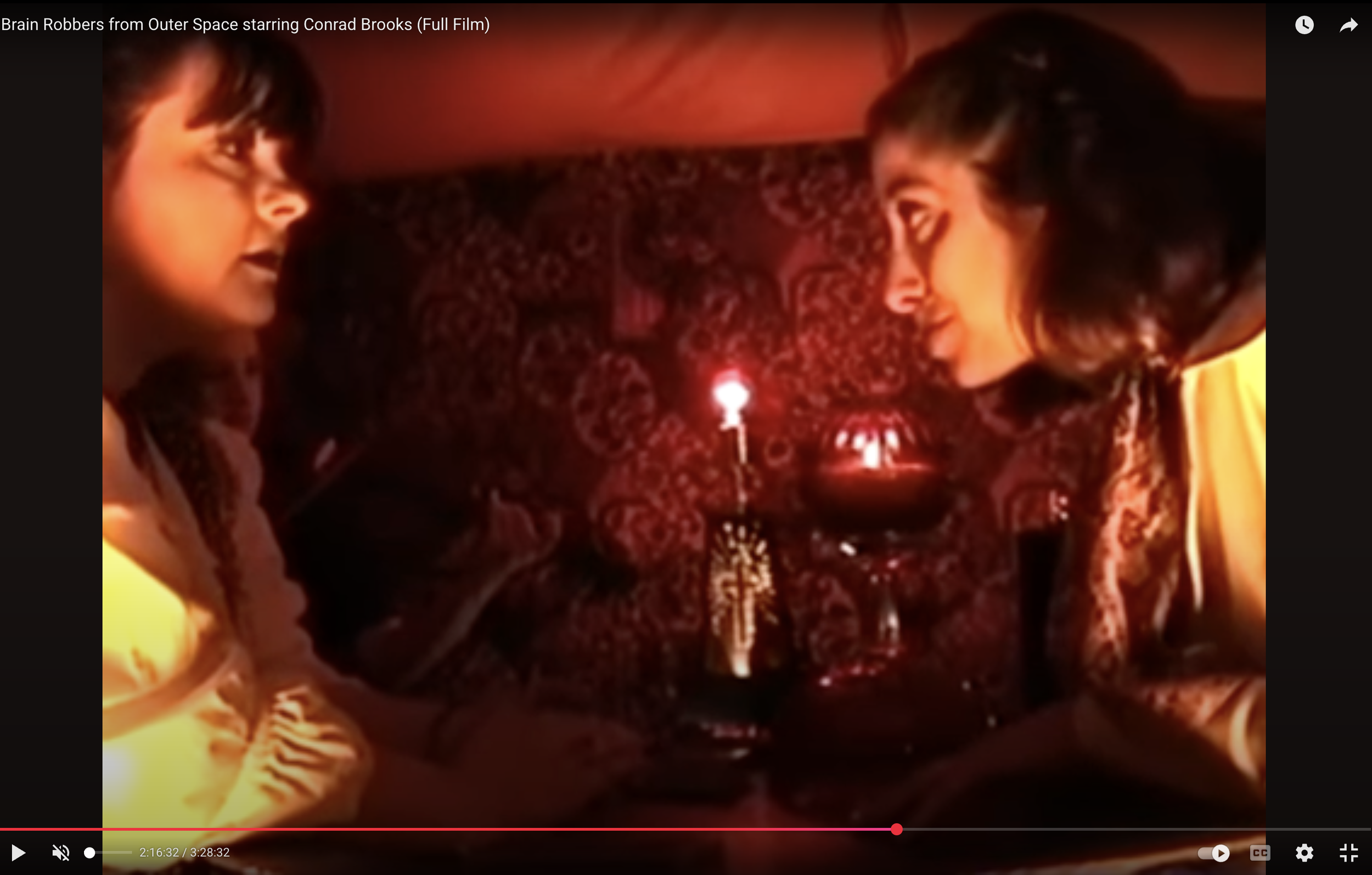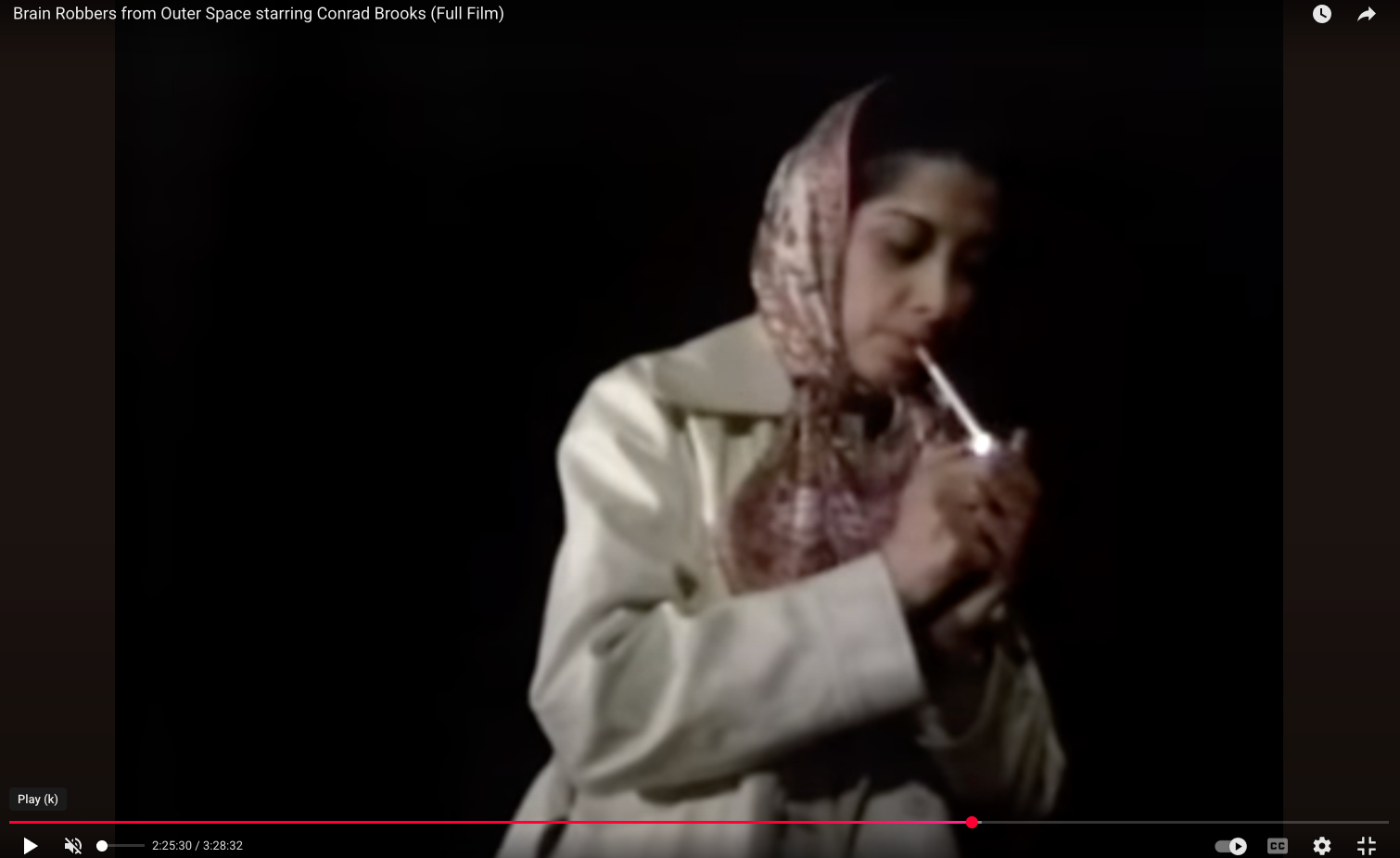Wholly Worthwhile: My Part in the Longest Bad Movie Ever Made
by Stefanie Kalem
Part One: The Office Job from Outer Space
I was 25 years old when I first got involved in the movie Brain Robbers from Outer Space, 28 or so when I shot my last scene. I had no idea the film was done until I googled myself in the early aughts and saw that I suddenly had an IMDB credit, for a title that one Letterboxed reviewer calls “the longest bad movie ever made. … An immensely entertaining, complete endurance test, but wholly & totally worthwhile for bad movie lovers.” Now that I am 53, I think that my loved ones could easily paraphrase that review on my headstone: Here lies Stefanie Kalem, an immensely entertaining, complete endurance test, but wholly & totally worthwhile.
But back in the mid-to-late 1990s, all I was thinking was “say yes to whatever weird shit comes your way.”
This particularly weird chapter begins at the first job I had that used my English degree: as a proofreader for The Flyer, a direct-mail publication not unlike the better-known Pennysaver, with probably a dozen editions throughout the greater Tampa Bay area. I was one of a team of four, all of whom had English degrees from the local state university. We didn’t have to check the tiny classified ads that those kinds of publications were known for. Our job was to ensure the integrity of the display ads that were the real money makers, glossy auto sales inserts and chaotic, double-truck Chinese takeout menus, that sort of thing.
This was a 24-hour operation, with presses and paste-up and salespeople and nascent computer publication technology, so there were three fully staffed shifts and they included proofreaders. I mostly worked second shift, 3-11 p.m., which suited my nightbird schedule, and choosing my dinners from a battery of vending machines holding such delicacies as pimiento cheese sandwiches was a gut-testing thrill. Plus, on the wall across from the machines was a mural-size photo of a green-blue ocean, as seen through palm trees on the shore of a tropical isle — who could ask for anything more? I sometimes worked third shift, overnight, when the printing crew would blast butt rock and leave Marlboro ends everywhere; and occasionally first shift, dragging my youthful ass in after a night of alcoholic experimentation, feeling like a cartoon character firing on two dimensions and roughly half my cylinders. Because I worked all these shifts, I got to work with the most dazzling array of creative eccentrics that Central Florida had to offer.
I had grown up on Long Island, and Central Floridians electrified my soft weird little brain. There was Bobbie, the former biker chick who put the editions together with an early version of Filemaker, so Elvis-obsessed that her son was born on his birthday and she claimed to have once seen Gladys Presley getting a dauber out of her truck at bingo. And graphic designer Lisa—they were called “composers” there—who made all of her clothing, including the garb for her Ren Faire lifestyle and a wedding dress that made me gasp with its luxurious intricacy. Another composer, Ray, who, when pressed, called me racist for asking him to clean up a blurry ad proof that made the model’s Black skin look mottled, and who therefore taught me about vitiligo and well-earned, well-kept rage.
And then there was Garland, whose whole job was to scan things the sales reps brought in so the composers could place them in ads. Garland had a ponytail and a beard, loved the Grateful Dead and the movies. Like most cinephiles, he appreciated all manner of film, but the dark stuff was where his interest really lay—he loved horror movies enough to name his son Damian (Damian will be important to this story, if I ever get around to it) and B-movies enough that, when he met Conrad Brooks, featured player in more Ed Wood movies than any other actor, one of the minor players in Ed Wood’s camp classic, they struck up a friendship that inspired Garland to make the sequel to Plan 9 from Outer Space, a project that would span two decades of his life.
Part Two: The Movie Shoots from Outer Space
At three-and-a-half hours long, Brain Robbers from Outer Space may indeed be the longest bad movie ever made. But it is also a testament to following an evolving, meandering bliss to wherever it leads you: Garland would write in every interesting person, place, and thing he encountered. That’s how I got there, anyway.
One day he and I got talking about Illeana Douglas, to whom my resemblance is still sometimes of interest to movie buffs, all these decades later. He ended up writing some scenes for me wherein I only said her lines from Goodfellas and Cape Fear. I then introduced him to the only other “old hippies” I knew (who were possibly, at the time, all younger than I am now): my friend Dawn’s parents. At Chaos Park, their tropical suburban property in Safety Harbor, artist Mitsy and scientist Harry threw epic parties for their kaleidoscopic variety of friends: the Valentine’s Day Bacchanal in February, the July 4 Freedom Frolic, and the May Day Goat Roast. So it was no big thing for them to throw another party just for Garland to shoot, including a psychic’s tent wherein I could smack gum and say my lines to an incredulous fortune teller as part of the filmed festivities.
While I was at The Flyer, I started writing about music for the local weekly newspaper; after a year or so, they hired me full-time as music critic (with other duties as assigned). My days and nights comparing multiple revisions of patio furniture inserts became late nights at live shows, followed by late mornings in the office, writing columns and reviews, supervising interns, and editing Free Will Astrology and Ask Amy off the wire. Some time toward the end of the millennium, Garland reached out to tell me he wanted to film another scene. The movie was nearly done, or so he said, and my character needed closure. She had no name but apparently she needed to die. And Garland had met the perfect person to do the deed.
While his son Damien, now a teenager, had been volunteering at the local public access station, he’d befriended a nice young man named Grady from Gibsonton, aka Gibtown. Grady’s father had been Lobster Boy, a sideshow celebrity from a long line of them. After Grady’s mother allegedly but successfully hired someone to kill her murderous, abusive husband, only 10 people came to his funeral. I encourage you to look up this story, if you haven't already. Grady Jr. was a piece of shit. Grady III, however, was a sweetheart. He had the same genetic condition as his forbears, Ectrodactyly, on his hands and feet. Upon meeting him, Garland asked him to come to a film shoot and kill someone.
We shot the scene on the sidewalk outside my friend Keri’s house—she had been one of the other proofreaders with an English degree at The Flyer, and at that time she and I and her housemates (like many folks in their 20s in the ’90s) had a Sunday night tradition of watching The Simpsons together. But Sunday night was the only night everyone could make it to filming, so Garland, Grady, and crew set up to Keri’s Seminole Heights street, I put on the same white pleather jacket and long scarf I’d been wearing at the shoot at Chaos Park and, since I had chopped off my hair by then, a wig for continuity. I filled my mouth with homebrewed fake blood, and—after he’d scuttled out from under the bushes a few times until he got it perfect—let Grady strangle me. I remember him suggesting the bush-scuttle himself, because he knew it would be scary. Reader, it was.
And just typing that leaves me marveling. Garland wrote as he went, even writing Keri into the scene: through the window she hollers, NIMBY rage strangling her voice, “Can you keep it down?! We’re trying to watch The Simpsons!” at the dying actress on the sidewalk.
In 2001, I moved to Oakland, CA, and that was where I was living the first time Garland sent me a VHS tape of Brain Robbers. It wasn’t done yet, he said, but he wanted me to have the latest cut. It was around two hours long at that point, and I remember watching it and thinking, well, no, it’s not done. The movie was officially released in 2004, but I didn’t know that it was DONE done until that IMDB credit came up. Reader, I have never been able to watch the whole thing. I want to. I love that it exists, love that I was a part of it. Like Garland, I have spent my life collecting interesting people, a habit that served me very, very well and one I likely learned watching him. But I’ve never been able to take the journey into this particular bit of cinematic outer space.
Welp… I guess it’s time for that to change.
Part Three: Brain Robbers from Outer Space
I have spent the last two weeks watching this movie. I have snuck in 15-minute blocks on my laptop between meetings and half-hour sessions on the big TV downstairs when my crazy new dog is worn out. I have taken copious, stream-of-consciousness notes all the way through. This all seemed like an appropriate way to watch a movie made over such a long time period with so many left turns, and with surrealism so deep in its DNA. As that Letterboxd reviewer says, it is wholly worthwhile for bad movie lovers, as well of those who love art that is proudly, passionately “B,” shot on a shoestring at convenient locations (I’m pretty sure the Flyer office serves as the interior of the police station) with background noise aplenty and psychedelic choices that practically roll the joint up for you and light it. Visual and textual nods to David Lynch’s cinematography, Ed Wood’s special effects, Russ Meyer’s softcore porn and catfights, and John Waters’ very existence are everywhere. New characters get introduced to talk about their area of expertise—feminist scholarship of ancient texts, morphogenic resonance, what have you—only to never show their faces again. But their concepts remain, and certain themes repeat even amidst the maximalist chaos.
The main characters are retired policeman Officer Jamey (Conrad Brooks); a sadistic alien queen named Morphea; a pair of argumentative, incompetent Men in Black in her service; identical twin sisters solidly representing the Madonna and the Whore; and a dude named Domino who may or not be a weed dealer. There are brain robbers from outer space, for sure, but the gray matter doesn’t get stolen until around the one-hour mark, leading to one of my favorite segments of the movie: a lovely, five-minute-long experience of strobe-lit mind swappage, with blood cells and dendrites and ancient iconography and synth beeps and heartbeats and insect hums and Timothy Leary talking-head clips and negative-printed drips on glass.
But listen, Reader—I got more than halfway through and had to start fast-forwarding. I was trying to follow a plot and that was my mistake. Did I speed through 45 minutes to get to my first scene at around 2:15? Yes, Reader, I did. I grew tired of watching my former coworkers read lines badly, and anxious to see my former friends. Turns out that, while my first office job makes for a good story, it’s my friends that my heart most wanted to revisit. The moment the gate opened to Chaos Park, I remembered entering those grounds for the first time, the brain-blasting feeling of being welcomed into that strange and wild space. And there it was for me to see in 2025 sound and vision: my friend Liza playing violin in the corner of the psychic’s tent; Jeff, age 26, who in the months preceding my writing this became a (young!) grandfather; Harry, who passed away around the turn of the millennium and who here gives one of the best performances of the film, charmingly attempting to buy more souls for his collection (his wife Mitsi, also gone, starred in an earlier scene, slipping something into a nosy neighbor's drink); their daughter Dawn Marie and so many of my other pals pretending to be soulless zombies. And me, so young and skinny, chewing with my mouth open as I overact the bejesus out of my Douglas-swiped lines.
I do not think I am very interesting nowadays. But I have been. I was! I was a part of Brain Robbers from Outer Space, and we are both, at times, immensely entertaining, an endurance test, and wholly worthwhile, even if most can’t stick around for the whole thing. I finished watching the movie, and this knowledge was my reward. But since this may not matter to you, I offer the following partial list of 1990s visual and textual references:
Many, many issues of The Weekly World News
Urge Overkill and Faith No More t-shirts
Duff beer cans and a boss named Mr. Burns
The Genitorturers (too Tampa-specific?)
Multiple X-Files references
Two buddies named Doofus and Buttwipe
A telephone and answering machine on a milk crate that is being used as a nightstand
Heaven’s Gate cult leader Marshall Applewhite
A copy of Crack Whore magazine
Honorable, not-so-strictly-’90s mentions are warranted for Rupert Sledrake and Art Bell.
I don’t talk to Garland these days. We’re connected on Facebook, a platform I rarely use. I am a person who has disappeared from his life, just as others have from mine. This is a thing that happens. This is a thing that has led me to collect less people. The internet of everything now connects us all in new ways, but those ways are often flat and one-sided, even when they are not supposed to be. Looking at interesting things doesn’t make you as interesting as being a part of them does. And this is one of the differences between youth and middle age, or at least it has been for me—one collects experiences while the other catalogues them, turning them over in various lights, looking for the meaningful angle. Luckily, some collectors aren’t afraid to share their collections with the world, and all you need to do is press play.
Stefanie Kalem is a writer who has lived in Oakland, CA for the better part of this century. She collaborated on the letterpress book The Glamour Requirement (find it in your local university library's special collection if you dare) and has done a gazillion other random writerly things (including for Jezebel).
Stefanie writes what she's thinkin' at stefaniekalem.com and on Substack as Buttoned Wrong. She also occasionally publishes under the nom de smut Fanny Bae.



